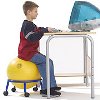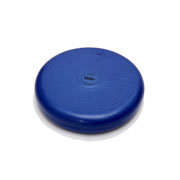
When Swiss exercise balls were originally developed in the 1960s for physical therapy purposes,
who knew that one day theyd be recommended for children with hyperactivity or sensory processing disorders?
But today, thats just whats happening.Ball chairs
(and balls used as chairs) & Kinder Ergo Sit
might be just what the doctor ordered to help children with sensory processing disorders,
Attention Deficit Hyperactivity Disorder (ADHD), or just a strong need to move reach their full potential in the classroom.
Around the same time that fitness fans began using Swiss exercise ball (also called fitness balls,
stability balls or therapy balls) in their exercise regimes as a way to strengthen abdominal and
back muscles, ball chairs were developed as a way to strengthen core muscles and improve
posture while sitting. During the 1980s, some occupational therapists began recommending
them to educators for classroom use, deeming them particularly helpful for children with
special learning needs.
Then in 2003, a study was published in the American Journal of Occupational Therapy
concluding that in students with ADHD, sitting on therapy balls improved behavior and legible
word productivity. In other words, students using ball chairs were able to sit still, focus and write more
words clearly.
Mayo Clinic in Rochester seconded those findings in 2007 with a study on the benefits
of a chairless classroom. In the Mayo study, which focused on improving
learning and reducing obesity by making children more active, researchers found that the ability to move around
more while sitting made the students more attentive. Mayo Clinic communications consultant Bob
burn off excess energy by bouncing on a ball.
Sitting still isn't always a good thing
Generally speaking, people dont sit still, says Diana Henry, an occupational therapist who
travels the country in an RV to offer school-based and individual occupational therapy services.
They are always wiggling around. The littlest kids are even more wiggly because their sensory systems
are still developing.
Thats why children need recess at school. Running and jumping and spinning and twirling and
swinging, says Henry. Those activities are very important for the development of childrens
central nervous systems, their brain and their body.
Some kids need more movement than others. And for some kids with a sensory
processing disorder or ADHD, being in motion allows their brains to be engaged. There is a neurological
pathway that goes from your bodys balance and movement system to your alert system
in your brain. Movement actually allows for alertness and attention, says Henry.
Thats where ball chairs come in. In response to the balls instability and in order to remain
balanced while sitting on one, the body instinctively and continually engages core muscle
groups. Constant movement is required in order to stay seated on the ball. And that movement,
however slight, helps them focus.
Parents, teachers put ball chair benefits to the test
Ball chairs are very good for children who need to move a lot, says Kay Barrows,
a retired elementary school teache. Barrows had such success in her classroom using a ball chair
for one special needs child that she pushed for and was awarded a district grant
to get ball chairs for her entire class. The chairs were helpful for special needs students
in particular, but I also saw a big difference in kids who were just always rocking in their chairs
and needed to move.
When a child sits on a Ball chair or Kinder Ergo Sit, they are able to direct their natural kinesthetic
energy and need for movement in a positive way, because the child on aBall chair or Kinder Ergo Sit
has to constantly move his body on the chair to maintain his balance.
So rather than squash a child's innate need for movement, Ball chairs & Kinder Ergo Sits
channel their physical energy in a positive way, allowing them to focus on their work more
completely and reach their full potential as learners.
Darcy Lewis, a mother of two sons with ADHD, has started using a ball chair at home.
They feel less fidgety and more relaxed when they sit on a ball and, by their own assessment,
are more able to concentrate, whether on homework or dinner conversation with the rest of the family,
says Lewis.
Parents like Lewis are utilizing the concept of classroom ball chairs and allowing their child
to use one in a home setting. To this end, a ball chair can be a great tool for your child,
however, it is extremely important that a small child doesnt sit on an adult size ball.
Its important that you just dont give them any ball, says Henry.
Its important that the ball fits the child. Strive for a 90-degree angle in the knee bend
when the child is sitting comfortably on the ball. A regular sized chair or ball may be
fine for an older or taller child.
What if your child is just plain ol' fidgety?
You can act on this research whether or not your child has SPD or ADHD.
As Henry and Barrows both note above, every kid has a need for movement. With or without
a real ball chair, here are some things you can do to give your children more wiggle room while doing
homework or other seated activities at home:
If a child-size Fitness Ball Chair isn't in the budget, have your child sit on an appropriate-sized
Swiss exercise ball (just the ball on the floor) while reading, doing homework, even watching educational
programming on TV.
Place a Fit band on the legs of a chair so your child can bounce her feet up and down while she works.
Tape sandpaper to the underside of a table or desk so your child can rub his fingers against it while
sitting for any task.
Provide a bin filled with objects your children can fidget with during time they are expected to sit still.
(Try Koosh balls, squeeze balls, stretchy animals and other tactile toys.)

Kinder Ergo Sit


 Active Sitting
Active Sitting

